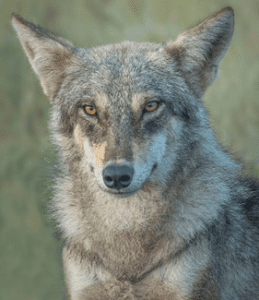TAG: GS 3: ECOLOGY AND ENVIRONMENT
THE CONTEXT: The Indian wolf (Canis lupus pallipes) faces a dire situation that has received far less attention than other iconic species in India like the Bengal tiger, Asiatic lion, Indian elephant, and one-horned rhinoceros.
EXPLANATION:
- Indian wolf is a flagship species for India’s grassland ecosystems.
- The Indian wolf’s conservation status is precarious, with an estimated population of only 2,000 to 3,000 individuals across the states of Rajasthan, Gujarat, Maharashtra, and Karnataka.
- This population exists largely outside protected areas, highlighting the urgent need for comprehensive conservation efforts.
The Unique Heritage of the Indian Wolf
- The Indian wolf, distinct from the Himalayan or Woolly Wolf (Canis lupus chanco), is a unique and ancient lineage that has been isolated in the Indian subcontinent for over 100,000 years.
- Wolves from Iran to Turkey are more closely related to European and North American wolves than they are to the Indian wolf, which underscores the uniqueness of this lineage.
Conservation Efforts and Challenges
- Recent initiatives have aimed to formally assess the Indian wolf’s conservation status as part of the International Union for Conservation of Nature (IUCN) Red List of Threatened Species.
- This assessment is crucial as it will classify the Indian wolf’s risk of extinction and provide a comprehensive review of its current threats, status, and population estimates in both India and Pakistan.
- This effort marks a significant step towards informing conservation policies and actions, as well as raising public awareness about the species.
- In Pakistan, the situation is even more critical, with Indian wolves on the brink of extinction.
- Only a few packs are believed to remain in the provinces of Sindh and Punjab.
- The lack of data on where these wolves still survive and the limited public awareness of their plight pose significant barriers to their conservation.
- Increasing awareness and support from local communities, government bodies, and the broader public in Pakistan is essential to conserve these remaining populations.
The Precarious Future of the Indian Wolf
- The Indian wolf’s survival is intricately tied to the fate of India’s grasslands, which have been rapidly vanishing due to human activities.
- With almost the entire population living outside protected areas, the future of these wolves largely depends on the actions of local communities and the collaborative efforts of government and non-governmental organizations (NGOs).
- Protecting critical denning sites during vulnerable periods is essential for their survival.
- While initiatives like captive breeding may offer some hope, the primary focus must remain on identifying and protecting the remaining breeding populations in India and Pakistan.
- Immediate and sustained conservation efforts are crucial to ensure that the Indian wolf does not follow the path of extinction.
Indian wolf (Canis lupus pallipes)
- The Indian wolf (Canis lupus pallipes) is a subspecies of gray wolf that ranges from Southwest Asia to the Indian subcontinent.
- It is intermediate in size between the Himalayan wolf and the Arabian wolf, and lacks the former’s luxuriant winter coat due to it living in warmer conditions.
- Within this subspecies, the “Indian plains wolf” is genetically basal to all other extant Canis lupus apart from the older-lineage Himalayan wolf, with both proposed as separate species.
- The Indian wolf travels in smaller packs and is less vocal than other variants of the gray wolf, and has a reputation for being cunning.
- The Indian wolf is one of the most endangered populations of gray wolf in the world.


